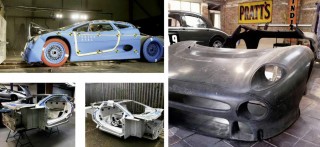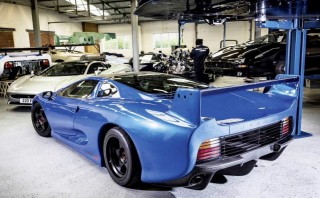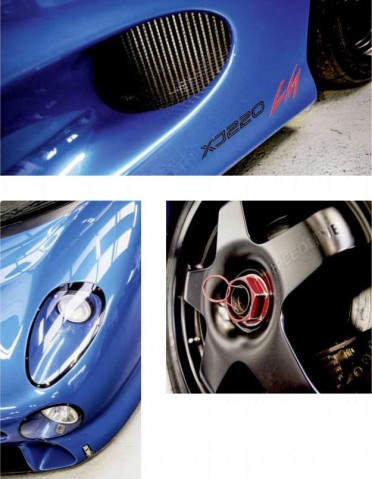COVER Epic Restoration Restoring any Jaguar XJ220 is daunting enough, but Don Law Racing resurrected the very car that was used for crash-testing at MIRA. We tell its remarkable tale.
There are, it has to be said, more promising projects than a car that’s been deliberately crashed into a wall at 30mph, stripped of many of its parts, then abandoned round the back of first Bloxham then Gaydon and finally at Jaguar’s Browns Lane museum. But Justin Law gave it a go anyway.

He says, ‘I used to own Tom Walkinshaw’s own XJ220S demonstrator, registered M1 TWR – the only development car fitted with an upgraded 680bhp engine. I sold it in a moment of weakness and have regretted it ever since – I drove that car every day. Then I borrowed it to give demonstration rides at Gaydon along with racer and XJ220 development driver Andy Wallace. It was fantastic fun and I left thinking “I really need one of those”.
‘This is the actual car JaguarSport submitted for the crash test at MIRA. My father Don and I had known of its existence for years. Then three years ago we bought two unbuilt XJ220s left over after production ended, and this came with them. At first we just saw it as an interesting piece of Jaguar history – it was Shell B of the development cars, predictably nicknamed “Carroll” at the factory. Then one day we had a proper look at the chassis and saw how good it was and how well it had survived the impact. The crumple structure had worked so effectively that the crash hadn’t cracked the windscreen or closed up the door gaps.
‘We had been buying up XJ220 parts for years and had a full set of carbon-fibre Le Mans panels, another shell with race suspension, plus the remains of the MIRA car. We also managed to acquire many of the componentry that had been removed from Shell B from the Jaguar Daimler Heritage Trust and other sources. I reckoned we could rebuild the car with the bespoke suspension, brakes, wheels and tyres that are unique to the LM – something like a Le Mans-specification XJ220, but in roadgoing form.’
ASSESSING AND PLANNING
‘More damage had been done by years of poor storage’
The car’s lack of completeness was less daunting for Justin than it might have been for someone else because Don Law Racing has gathered up most of the remaining parts for these cars, and where necessary remade items from scratch. But that still left an enormous amount of work to do and tricky problems to solve, the first being the car’s main tub.

‘The impact actually wasn’t the worst part of it,’ says Justin. ‘In fact, apart from the front section, the chassis was straight. More damage appeared to have been done to the tub by years of poor storage. Water had penetrated areas of the car’s aluminium honeycomb structure and caused delamination, especially in the floorpan. The car’s design meant that in effect all we had to do was unbolt the crush structure at the front and bolt a complete new section on.
‘Then I dummied up various digital images of it in different colours and settled on Audi Sprint Blue – the same colour as my Audi RS4.
‘The original engine was long gone, so I started with a brand-new block and cylinder heads, which I handpicked from our stock.’
BODY AND CHASSIS
‘We had to invert the bodyshell to fit the complete new floor’
Jeff Wilson is an experienced fabricator who worked for TWR when the XJ220s were being built. He says, ‘It needed a complete new floor section so we had to invert the shell on our jig and remove the floor leaving all the vertical castellations intact. It’s a job that demands considerable patience. Dealing with damage to honeycomb structures is similar to dealing with rust – simply cut out the delamianted areas and replace them. The big difference is that the new sections are glued in place using expensive 3M 9323 two-pack aircraft adhesive then riveted – not welded – with joint panels. We usually buy the original aerospace-spec honeycomb in 8ft x 4ft sheets, though they had to be a bespoke size for the wider XJ220 floor. They cut easily with a jigsaw then the new sections are bonded in.

‘The crash test had damaged the front bulkhead, which is a CNC-machined aluminium panel. We had one in stock, but the patterns are there to make a new one if necessary. We mounted the chassis on to a jig and bolted and riveted the bulkhead in place. Then we bolted a new front crush structure to it.’
Justin adds, ‘With the tub straight and sorted, we did a full “dry build” and fitted all the Le Mans carbonfibre panels to it. These were designed to be easily removable on the race cars with bolts and quick-release catches but we wanted to bond them into place so there was a lot of tweaking to do. They might have been 20-year-old panels left over from the race programme, but they all went together really well.
‘The one big change we made was in joining the panels together above the side intakes like they are on the road cars. On the racers they’re split to allow the whole upper rear body section to be quickly removed for good engine access. We bonded them together and filled the join with 3M epoxy filler.
‘The main issue with composite panels is sealing the surface before painting because it’s very porous and pinholes easily. To do this we apply several thin coats of a special two-pack hydroxyl acrylic primer then leave it as long as possible to see if any sinkage or other flaws appear. We didn’t use a high-build spray filler because we wanted to keep the weight down. In certain lights you can still see the weave of the fibres underneath. ‘We have moulds to make XJ220 doors from scratch, but ended up fitting original 1993 Le Mans carbon-fibre doors and polycarbonate windows. This saved a considerable amount of weight because standard XJ220 doors are extremely heavy.
‘We’d already had a batch of heated windscreens made and used one for this car because there’s no air conditioning fitted – again this was to keep weight down and avoid power drain.
The door mirrors look bespoke but were actually easy to find because they were popular at the time and used on cars such as the TVR Griffith.’
EXPERT TIP
‘When dealing with joints between sections of aluminium honeycomb, we use a special 3M epoxy filler – which is half the weight of regular stuff – to seal the joins and keep moisture out.’
RUNNING GEAR
‘The gearbox was incomplete and there are no spare parts’
Merely building up an engine wasn’t enough for the guys at Don Law Racing. Justin says, ‘One particular element of this project was to explore the limits of what we could do with an XJ220 – and that meant getting more power out of the engine. I already knew its weak points so knew where to go with it.’

Don Law (pictured above) adds, ‘We used conrods machined from billet and had forged pistons made, both to Le Mans spec, along with valve springs custommade to a design somewhere between standard XJ220 and Le Mans specification. The turbochargers are Garrett M27s and use roller rather than plain bearings so they spool up more quickly. We machined the block and cylinder heads to take Coopers rings rather than head gaskets for better sealing under pressure and modified the fuel system with new injectors and pumps to deliver more fuel. ‘The radiator has 30 per cent more capacity than standard and we fitted it with a pair of 16in two-speed electric fans.’
Back to Justin. ‘We made a new exhaust system with a 3in rather than 2.5in bore, removed the catalytic converters and built a repackable silencer box, so we have options on the amount of silencing we use. We also ceramic-coated a lot of the external engine parts in black to help keep heat down in the engine bay – and it looks pretty cool too!
‘It delivers 700bhp, which is more than enough for road use – the standard cars have 542bhp – but there’s a switch on the dashboard that gives you a remapped 800bhp on high-octane fuel for track drives.’ The gearbox turned out to be something of a stumbling block. ‘The transmission was incomplete and off-the-shelf spares are no longer available so everything had to be made from scratch using our drawings,’ says Justin. This included some of the gear cluster, detents, part of the shift linkage and various other incidentals.
Thank goodness that we have the patterns for everything! I took a great deal of care over the assembly because these transmissions are right on their limit even with the standard engine. The original transmission fluid is no longer available, so we had to have a new one developed for us by Morris Lubricants, which we now use in customers’ cars.
‘We machined new suspension rockers from billet aluminium because the original cast ones have been known to crack, especially at the rear. We used adjustable Ohlins dampers instead of the original non-adjustable Bilsteins to allow for fine-tuning, along with magnesium uprights with six-piston AP calipers – as per 1993 Le Mans specification.
Jeff Wilson fabricated lighter front wishbones out of 4130 steel, which we heat-treated then finished in Kephos, a durable lightweight coating that you can crack-test the welds through.’
EXPERT TIP
‘You always struggle with clearing airlocks in XJ220 cooling systems. On this car we added a swirl pot and header tank that helps eliminate those issues and also helps improve cooling, especially alongside a higher-capacity radiator. The latter is also essential for use in hotter climates.’
THE RESULTS
‘From the M1 crawl to flat-out down Silverstone’s main straight’
‘It was a real rush to get the car finished,’ says Justin. ‘I had – perhaps optimistically – booked it into the Cholmondeley Pageant of Power, so we pushed really hard to get it ready. I really wanted a set of carbon-fibre-backed Recaro race seats in keeping with the Le Mans theme but I couldn’t find any that looked right. At the finish I just threw in a pair of period-correct road-spec Recaros just so there was something to sit on, but they’re so comfortable that we’ve kept them.
‘It was a close-run thing – I first drove the car very briefly at 6pm the night before Cholmondeley, then jumped into it the following morning and headed straight to the Pageant. There was no time at all to test or adjust anything. By that point I just wanted to get through the weekend without any drama and get the car seen by the public. But we got there and back and completed the event with no problems.
‘I also took it to the Silverstone Classic press day. When I got there we put on slick tyres and took journalists round the track on demonstration runs for an hour and a half. The XJ220 coped with the whole day really well, from crawling along in heavy M1 traffic to flat-out down Silverstone’s main straight.
‘The engine’s phenomenal torque cancels out the usual turbo lag you get with these cars, and it’s almost sitting at idle at 100mph – perfect for a run to the south of France. This is currently the only roadgoing XJ220 LM and if I’m honest it’s a bit much for the road. But we already have an order to build another.’
Thanks To: Don Law Racing (donlawracing.com)

After the 30mph impact at MIRA. Jaguar’s structure proved to be very resilient – even the windscreen survived. Body shell at Don Law Racing awaiting assessment As found at Jaguar’s Browns Lane facility.
Jeff Wilson worked at TWR when these cars were being built.
Composite panels were left over from the 1993 Le Mans racer project.
Engine has been modified to pump out 700bhp in street trim. A flick of a switch liberates a full 800bhp for track outings.
Removable Motec dash unit is used for data gathering.
V6’s extensive black ceramic coating helps to keep engine bay temperatures down Le Mans panels trial-fitted during the Jaguar’s ‘dry build’
Just back from the paint shop and being fitted with temporary alloys to move it about
Speedline wheels are the same as those used on 1993 LM-spec cars.
Huge wing and lack of side rubbing strips distinguish LM from regular XJ220.
Subtle badging, but not-so subtle Audi Sprint Blue paint is the same as on Justin’s RS4 daily driver.
Left: fixed lamps are much lighter than original pop-ups.





